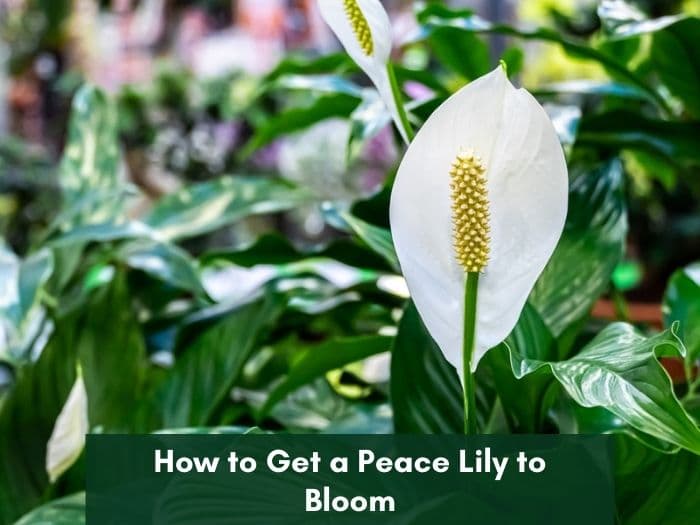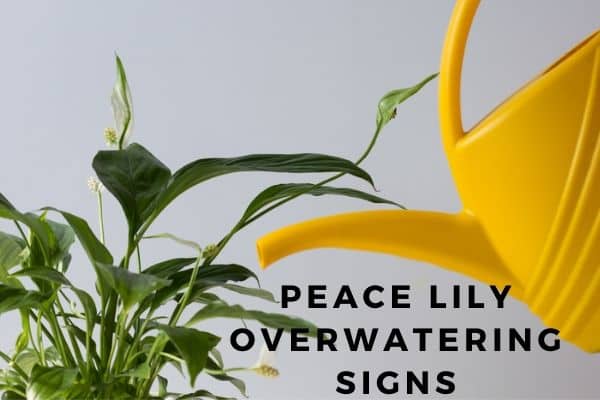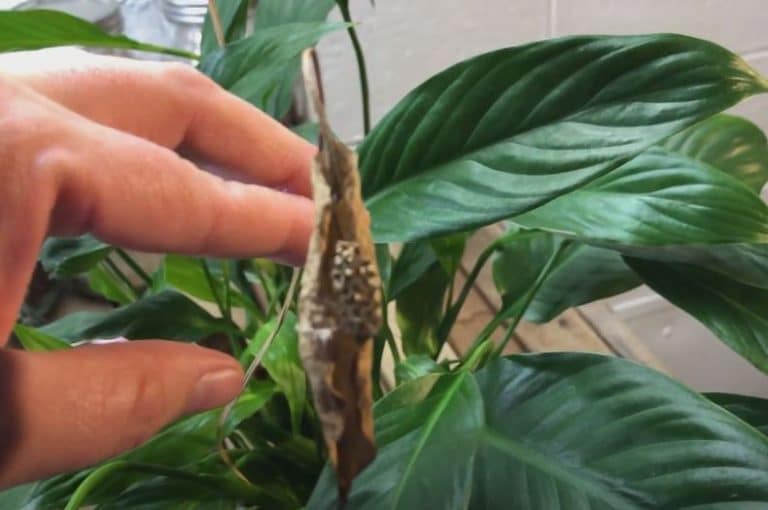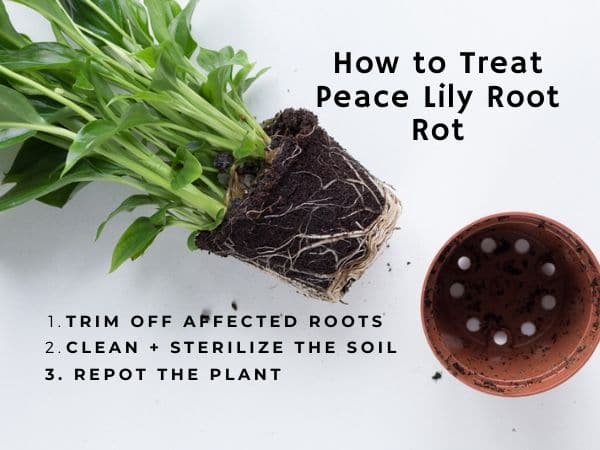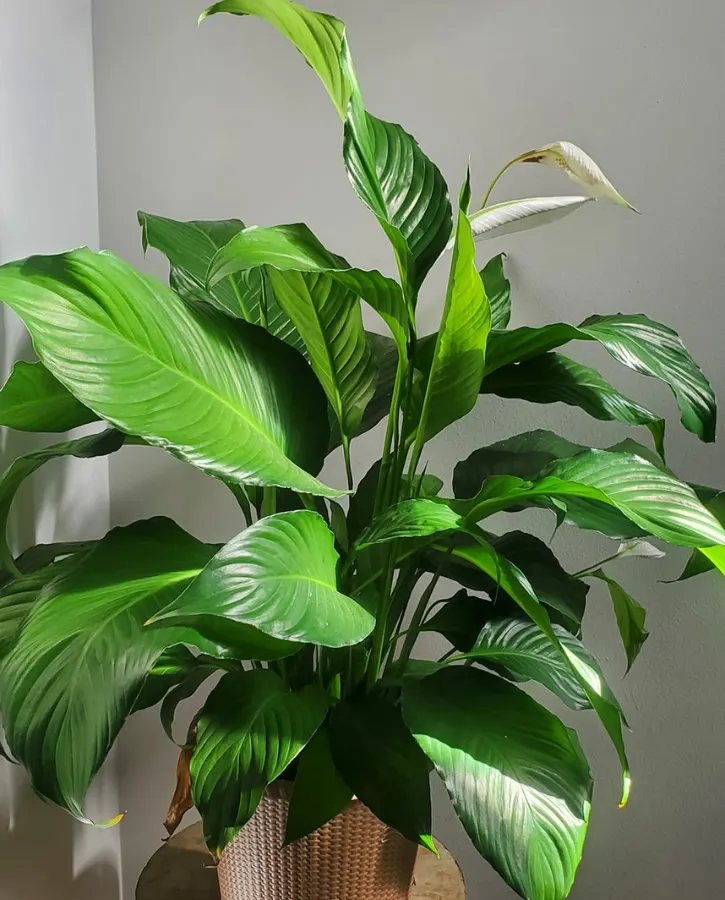How do I revive a drooping peace lily?
Drooping peace lily leaves indicate problems in that pot. Wilting is a common sign that the plant is dying due to water problems, but other underlying issues may exist. So, why is your peace lily droopy, and how do you revive it?
The main reasons for drooping in peace lilies are overwatering, underwatering, overexposure to sunlight, root rot, and repotting shock. To revive the plant, repot it in a well-draining soil mix and pot, then place it under partial shade.
Water the peace lily only when the top inch of soil is dry.

Hello, I’m Alex Worley, a certified master gardener and plant care expert. I’ve successfully grown and sold thousands of peace lilies in our nurseries and I’ll help you troubleshoot your plant and revive it.
Contents:
5 Causes of a droopy peace lily
Here’s why your peace lily may be wilting:
1. Overwatering
Overwatering your peace lily leads to waterlogging in the pot, making it difficult for the peace lily to breathe and draw in nutrients.
The plant’s leaves start to droop, especially if the container does not drain water properly. This happens because it is not able to photosynthesize properly due to suffocation.
Here’s how I tell a peace lily is overwatered:
- Drooping leaves
- Lower leaves turning yellow
- Black-tipped roots
- Brown leaf edges and tips
- Dark brown spots on the stalks
Overwatering indoor plants often causes root rot, including Rhizoctonia root, rot, Phytophthora, Pythium, and Cylindrocladium. All these are fungal infections.
2. Underwatering
Lack of water will make your peace lily dry out and wilt. When I see slight wilting and drooping, I check the moisture content of the potting mix and irrigate it if it is dry.
If your peace lily has gone too long without water, the leaves will start to hang due to loss of turgidity or turgor pressure.
This houseplant’s lack of water shows signs of an overwatered peace lily. Some leaves may start to turn yellow as they wilt.

Eventually, you may need to prune the affected leaves of your peace lily for the plant to resurrect or revive.
Pro tip: Peace lily plants are fairly forgiving if you don’t water them correctly. The leaves will soon start drooping when the plant dries out, but it will rebound quickly when watered.
3. Overexposure to sunlight
The next point of diagnosis is the plant’s location. Have you placed it in too much sun?
The rule of thumb is to place peace lilies where they’ll receive bright indirect sunlight. If you expose the plant to too much direct sun, the foliage will droop and show signs of burning.
The wilting is a result of a higher rate of transpiration. In simple terms, the plant loses water too quickly, making its leaves droop and wilt.
3. Root rot
Root rot may be one of the reasons why your peace lily is droopy. When plants sit in excess water for long, the roots become too wet, leading to root rot disease.
Signs of root rot may include the following:
- Yellowing leaves
- Wilting leaves
- Mushy, weakened, and rotting roots
- Roots turning black
If the wilting persists, you might want to change the soil because it is already infested with a fungus.
4. Repotting shock
Did you transplant your peace lily? After repotting, it is normal for houseplants to suffer shock and show signs such as drooping and wilting. A common mistake I encounter is fertilizing soon after repotting.
I recommend not to fertilize or water the plant (unless the soil is completely dry).
Common symptoms of shock are wilting leaves, leaf rolling and curling in peace lilies, and yellowing. Leaf death may follow if you do not remedy the shock.
How to Revive a Drooping Peace Lily
Here’s how to revive a droopy spathiphyllum:
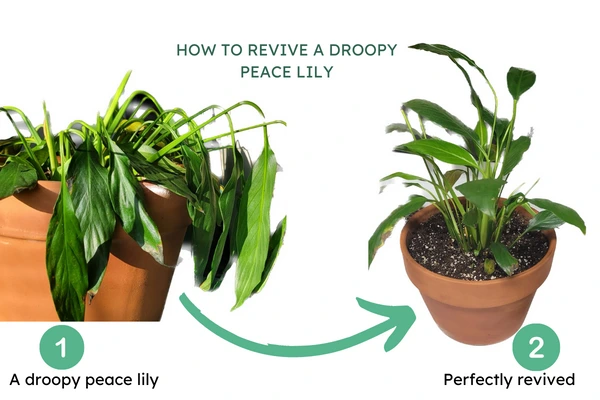
1. Drain the soil
Drain the potting soil if there are excess water and soil drainage problems.
Simply create some holes in the base of the plant’s pot to allow excess water to drain out. Remember, the aim is to keep the soil moist and not drenched.
Peace lilies are water-thirsty plants and can do well if the water can drain through holes at the bottom of the pot.
Pro tip: Test for waterlogging by pushing your finger into the potting soil up to the second knuckle. If it comes up too wet, there’s too much water in the pot.
2. Water when the top inch of soil is dry
The best fix for a drooping peace lily is to let the top inch of its potting mix dry out before watering again. A good watering frequency is once a week, but don’t be strict with it.
In the summer, spray the leaves every other day with distilled water to reduce water loss through the plant’s leaves.
Pro tip: Peace lilies require slightly more water than usual when blooming, so the plant can wilt easily if not watered for a long time. The plant may not bloom if not well taken care of.
3. Move the plant away from direct sunlight
An excessively transpiring peace lily will keep drooping even with adequate watering and feeding. Move the plant to a shady area to fix the drooping caused by excess sunlight.
For example, if you’ve placed the pot near the window, move it away into a partially lit area.
If the lily is out on the patio with direct sunlight, move it to a place with less sunlight to stop the wilting.
Pro tip: Choose a bright spot in your house or garden that does not receive direct sunlight. Shady corners in the patio are great places for peace lilies.
4. Treat root rot
If fungal-infested roots are the reason for drooping in Spathiphyllum, you might want to treat the soil, roots, and even water completely.
Here’s how to treat root rot and revive your peace lily:
- Change the potting soil to get rid of the soil with the fungus in it.
- Clean and sterilize the potting container using a weak hydrogen peroxide solution.
- Trim the rotting roots on the peace lily to prevent infecting the healthy roots.
- Clean the remaining roots to get rid of any fungal spores.
- Repot the plant in a healthy potting mix.
After repotting, it is normal for the plant to show signs of stress. Just allow it a few days to revive and grow healthy again.
5. Treat with vitamin B1 when repotting
When the problem is droopy leaves after transplant, you may need to start repotting your peace lilies with a treatment of vitamin B1 to help with root development.
An alternative is a starter fertilizer for houseplants to help with root development. Be careful not to apply too much fertilizer on your houseplants as it can also cause burning and intoxication, especially if you feed with nitrogen fertilizer.
Is a droopy peace lily dying?
Drooping indicates that the potting mix is too dry. If you leave your peace lily without water for too long, it will dry up and die.
A great way of knowing the peace lily is dying is to check the bottom leaves. If they’re drooping and turning brown or yellow, the plant is dying from lack of water and too much sunlight.
Before applying any fix, I recommend checking the soil for moisture using a moisture meter or index finger. If drought is the problem, water adequately and allow excess water to drain through the holes in the planter.
Peace lilies like partial shade and will easily lose excess moisture when sitting in bright direct sunlight. Move the plant indoors in a shaded area to reduce water loss and stress.
Why is my peace lily drooping after repotting?
Your peace lily may start drooping after repotting because it is in shock, does not have enough water, or there’s too much water. Soggy soil after watering causes waterlogging and impairs water and nutrient absorption, making it droop after repotting.
If you just repotted your plant, ensure the soil is moist but not too wet. That should be enough to revive the indoor plant, but if it starts to wilt again, try watering to ensure the soil does not remain dry for a long time.
How long does it take for peace lily to stop drooping?
If the problem is dry soil, the plant will recover within hours. However, complete recovery depends on the severity of the wilting and can take as long as 2 weeks.
Why is my peace lily drooping but the soil is moist?
Drooping even when soil is moist could indicate other problems in your peace lily, such as root rot, too much sunlight, or transplant shock.
Video
Conclusion
You can prevent drooping in peace lilies by improving drainage in the pot, watering only when the soil mix dries out, and treating root rot disease. Give it a good watering each time, and let the water drain from the bottom of the planter.
Also, if it is rootbound, it’ll keep drooping EVERY time you water it. Check the roots and make sure it isn’t root-bound. If it is, repot in a pot 2 inches bigger than the current one. Use a new potting mix.
By the way, if you have a passion for gardening and growing plants, explore the plant nursery job opportunities on Jooble to turn your hobby into a source of income.
References
- Purdue University, Cooperative Extension Service: Transplant Shock of Trees and Shrubs


